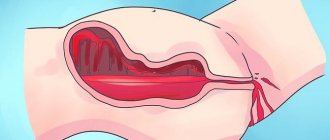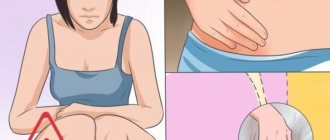The moment the baby is born, the mother’s body begins the postpartum recovery process and a regimen for maintaining the baby’s health through breast milk. During such a difficult period, women experience lochia - bloody vaginal discharge that forms from an open wound at the site of the placenta. At first they are too abundant, but gradually the liquid changes its color towards brownish, pinkish, yellowish and eventually transparent. This will happen until the wound heals completely. Therefore, for the next two months, the new mother will have to wear special pads and carefully monitor all changes.
If recovery proceeds without any complications, then lochia does not have a strong odor and does not cause much discomfort. However, there are frequent cases of the appearance of a green tint of secretion, which indicates the presence of deviations. A gynecologist will help you figure out what exactly happened and what to do next.
Is yellow discharge after childbirth considered normal?
Yes, if:
- They appeared at the end of the recovery period after childbirth;
- There is no pain or itching;
- A small amount of;
- Without bright color and unpleasant odor.
- The discharge lasts no more than two months.
Discharge from the birth canal should be under constant monitoring of the woman, as they are sometimes a sign of incipient infections or inflammatory processes.
Any deviation should arouse the woman’s close attention and serve as a reason to contact a specialist who will either reassure the patient or prescribe adequate treatment for the existing problem. Yellow discharge after childbirth is a sign of pathology in the following cases:
- Vibrant color intensity;
- Unpleasant odor;
- Burning and itching in the genital area;
- Nagging pain in the lower back or lower abdomen;
- Increased body temperature.
Any of these symptoms is a reason for immediate medical consultation.
Causes of yellow discharge during the postpartum period
In the postpartum period, there is a high risk of infection, since access to infections is completely open - there is an extensive wound surface, sometimes sutures, hematomas.
Yellow discharge may be a sign of inflammation of the uterus - endometritis. This disease develops very quickly and can dramatically worsen your health condition, so a visit to the doctor should not be postponed. Maintaining intimate hygiene will be a good prevention of possible complications during the postpartum period:
- Hygienic shower several times a day. The bath can be taken only after the end of the postpartum period in order to avoid infection in the birth canal.
- Change sanitary pads at least every 4 hours. Avoid scented and mesh pads to avoid allergic reactions and irritation. The surface of the pad in contact with the perineum should be “breathable” so as not to interfere with rapid healing.
- Tampons are prohibited during this period, as they interfere with the outflow of lochia and can provoke the appearance of an infectious focus.
- Douching is not allowed! There is a risk of infection.
- It is worth refraining from intimacy for one month after childbirth, until the uterus is completely restored.
Involution of the uterus will occur much more quickly if a woman is breastfeeding her baby.
Attachment to the breast causes the release of the hormone oxytocin, which acts on the contractile function of the uterine muscles, and, consequently, its restoration occurs more intensively. What color do you like? Red, yellow, green, white, pink? Or maybe brown? We don’t know your color preferences, but we can say with complete confidence which colors of postpartum discharge gynecologists and obstetricians do not like, and when they see them, they subject the woman to a thorough examination with passion. The least favorite colors of discharge in the spectrum of doctors are yellow and green, as well as their variations.
Yellow discharge after childbirth does not always indicate that something is wrong in the body. First, let's figure out what postpartum discharge should be like immediately after childbirth, after a week and after 1-2 months, when it ends.
Infection Prevention
To prevent infection, a woman should take a shower several times a day and wash herself with natural soap. Change pads every three hours or even more often. Gaskets should be made from natural materials and always clean.
The use of gaskets containing synthetic fibers is not allowed. They should not be flavored. It is strictly forbidden to douche or use tampons.
While there is vaginal discharge, it is not recommended to be sexually active. Sexual intercourse can cause more than just infection. In addition, damage to the vagina is possible. And this is extremely undesirable after childbirth, as it is fraught with possible complications.
Red discharge
After childbirth, all women experience vaginal discharge, which lasts on average from a month to 8 weeks. They are called lochia, from the Greek lochios - “relating to childbirth.” Their composition and process of secretions are similar to those that occur during the healing process of wounds. And no wonder - after all, after childbirth, the uterine cavity is an extensive wound formed after the separation of the placenta, or placenta.
In this way, the endometrium (inner lining) of the uterus is cleansed and restored. Over time, the composition of the lochia changes, as does their color. In the first 2-3 days after childbirth, lochia is abundant and bloody; regular menstrual pads are sometimes unable to cope with their volume and special postpartum or urological pads are required. Such lochia are also called red.
Injured arteries and small vessels bleed, which during the process of uterine contractions are drawn deep into the cavity and thromboses. The composition of lochia during this period is dominated by erythrocytes. After a cesarean section, lochia remains bloody for longer due to the longer recovery process of the uterus.
Serous discharge
After 3–5 days, the lochia lighten and a period of serous lochia of brownish and yellow-gray color begins.
They become more serum-like and appear as liquid containing blood clots. In terms of composition, leukocytes come to the fore, displacing the previously predominant erythrocytes. Blood and mucus clots are parts of the sloughing lining of the uterus and the epithelial cells lining the lining.
Causes of hormonal imbalance after childbirth and methods of treating pathology
White discharge
A week after birth, there are practically no red blood cells in the lochia and they are completely replaced by leukocytes. If blood clots appear occasionally, then this is also normal. The amount of mucus secreted partly by the cervix increases significantly. Lochia appears as an opaque yellow-white or grayish-white, sometimes pink, liquid. Pink discharge indicates that a small amount of blood is mixed with it.
Under absolutely ideal conditions, with complete renewal of the uterine endometrium, lochia stops by the end of the third week after birth. In practice, this process is individual and often takes 6–8 weeks, depending on the speed of regeneration of a particular organism; on average, it takes a month. A few days before the discharge stops, lochia takes on the appearance of glassy transparent mucus.
The smell of lochia is due to the presence of bacteria in them.
Normally, it is moist and musty, reminiscent of the smell of normal menstruation.
Previously, it was believed that after childbirth, microorganisms are contained only in the vagina and partially in the uterine cervix. Recent studies have shown that the uterus is free from their presence only in the first three days after birth.
After this period of time, bacteria (cocci and other bacilli) freely penetrate into the uterine cavity and do not manifest themselves in any way until favorable conditions. When fluid stagnates in the uterus and genital tract, they begin to multiply and the smell of lochia becomes putrid, which does not indicate an inflammatory process in the absence of fever and good health.
As you can see, liquid yellow discharge after childbirth with blood clots and mucus is a completely natural and harmless phenomenon if it occurs 3-5 days after birth and is not accompanied by any alarming symptoms such as a rise in body temperature, purulent nature of the discharge and the addition of a strong putrefactive odor.
Allergies during pregnancy: treatment without harm to the baby
Physiological etiology
The so-called “white” lochia begins 7-10 days after birth. They are transparent or white, stretchy. Also, many women compare them to snot. There shouldn’t be any unpleasant odor, much less a high temperature!
The main cause of mucous discharge is fluid that passes through the blood vessels and lymph nodes:
- Uterine cells are capable of secreting transudate;
- During ovulation, mucus leaves the cervical canal;
- The cervix has the ability to secrete.
It is noted that the cells are especially active in the second phase of the menstrual cycle, at the time of ovulation and a few days before it. This happens under the influence of hormones. This ensures better lubrication and the environment in the vagina becomes less aggressive for sperm. The mucus that clogged the cervical canal and cervix in the first half of the cycle begins to move away and is released. All these are necessary conditions provided by nature for fertilization.
It is possible that the mucus that appeared in the discharge may either remain there or disappear when the postpartum period ends. The processes occurring in the body of each woman are individual.
It was also revealed that the nature of the discharge depends on whether the woman is breastfeeding her newborn baby. Breastfeeding (without complementary foods) inhibits the processes in the brain responsible for regulating the menstrual cycle. Therefore, it is difficult to predict whether mucous discharge will stop or whether menstruation will begin.
When to be wary
If a month later you have yellow, green discharge after childbirth, or yellow-green, purulent discharge, unpleasant and strong-smelling, then this may indicate the presence of a pathology. The final diagnosis can only be made by a doctor during examination and based on the results of laboratory and other tests, but we will consider the most likely possible causes.
Why and how your breasts hurt during and after feeding your baby
The appearance of thick yellow or green discharge with an unpleasant odor after childbirth is a signal calling for an immediate visit to your gynecologist. Without proper treatment of any inflammation of the genital organs, you can get a chronic form of disease, which subsequently leads to infertility, miscarriage and increases the risk of cancer.
Over the course of several weeks after the birth of the baby, the lining of the uterus is restored. In a young mother, this process is accompanied by discharge (lochia) from the vagina. What are they, and when can symptoms of diseases in the body appear? Let's try to figure it out.
It should be immediately noted that the nature of the discharge after childbirth gradually changes, and what color it should be cannot be said with certainty. Throughout the postpartum period, the shade of lochia varies. At first they look like menstruation and are red in color, but then their shade changes.
Causes
In women, discharge with a greenish tint is a consequence of inflammatory diseases of the vagina, cervix and uterine body, fallopian tubes and ovaries. Greenish discharge is determined by the admixture of leukocytes in the mucus. However, green discharge is not always due to the introduction of microbial agents.
Many women experience green, odorless discharge. If greenish, odorless discharge is observed, the reasons for this may be:
- allergic reaction of the vaginal mucosa to hygiene and care products, underwear, talc, etc.;
- reaction to wearing tight underwear (thongs, etc.);
- menstruation, before and after which light white and sometimes greenish discharge from the vagina is often observed.
A change in the shade of vaginal secretion can be observed at the beginning of sexual activity or when changing sexual partners. This may serve as a sign of adaptation to a new, unusual microflora. But most often, heavy discharge is the result of problems in the organs of the reproductive system. The reasons for the appearance of green discharge are varied. The appearance of pathological vaginal secretions can be provoked by: diabetes mellitus, prolapse of the vaginal walls, tumor and immune diseases.
Bacterial vaginosis
This disease causes excess, thin vaginal discharge. As vaginosis becomes chronic, the discharge becomes thicker and scantier with a yellow or green tint. The mechanism of development of vaginal vaginosis is based on a violation of the normal physiological composition of the vaginal microflora. The causes leading to vaginosis are improper douching, allergic reactions of the vaginal mucosa, immune disorders in the body, taking hormonal drugs and antibiotics, violation of intimate hygiene rules, hormonal changes during puberty, menopause and intestinal dysbiosis.
During the development of bacterial vaginosis, the normal vaginal microflora is replaced by anaerobic microorganisms: gardnerella is often detected in smears. However, according to the latest data, it has become known that gardnerella itself does not cause pathology, but has a negative effect only in association with other microorganisms.
With vaginosis, corynebacteria, epidermal staphylococcus, mycoplasmas, lactic streptococci and other microorganisms are often detected in the vaginal contents. A special feature of vaginosis is that abnormal microflora does not provoke inflammation and there is no significant increase in leukocyte accumulations. The trigger for the development of vaginosis is a decrease in the population of lactobacilli on the surface of the vaginal epithelium, which normally constitutes 98% of all microorganisms, while the pH varies in the range of 3.5-3.8.
Important! Any interventions, diseases, or manipulations that lead to a change in pH provoke the occurrence of vaginosis and colonization of the vaginal epithelium with microflora that is unusual for it.
During menopause, the concentration of estrogen in a woman's blood drops. This leads to a decrease in glycogen reserves in the vaginal epithelium, which deprives lactobacilli of a nutrient substrate. These events cause a decrease in the number of lactobacilli and provoke vaginosis. Treatment of vaginosis is aimed at restoring normal microflora and correcting pH, getting rid of bad habits, treating intestinal dysbiosis and other associated diseases.
If inflammation develops, yellow discharge or white-green discharge appears. If your symptoms include pain in the lower abdomen and high fever, you should immediately see a doctor. If light green discharge appears, a woman should consult a doctor to prevent possible complications. The color of vaginal secretion is sometimes light green. His appearance should also not be ignored.
Trichomoniasis
Often, the appearance of yellow-green vaginal discharge indicates sexually transmitted diseases. If you have yellow-green discharge that is odorless, it could be trichomoniasis.
Trichomoniasis is accompanied by a burning sensation, odorless, itching, and a foamy discharge. The clinical picture is similar to vulvovaginitis. The causative agent of trichomoniasis is Trichomonas vaginalis. Infection occurs through sexual contact. The pathogen does not live in the external environment. It is necessary to promptly treat trichomoniasis, since in advanced cases it causes infertility, complications of pregnancy and childbirth, and pathology of newborns.
Vaginal candidiasis - thrush
With candidiasis, a characteristic green, cheesy discharge with an unpleasant odor is noted. The causes of candidiasis are varied:
- stressful situations;
- taking antibiotics;
- failure to comply with personal hygiene rules;
- decreased body immunity.
After "Terzhinan"
When diagnosing an inflammatory process at the level of the vagina and cervix, the attending physician is faced with the task: how to competently treat this pathology? In the absence of general symptoms, local therapy is used, and often the choice falls on Terzhinan suppositories. Also, Terzhinan suppositories can cause atypical vaginal secretions.
"Terzhinan" is a complex drug widely used in gynecology. It contains: ternidazole, neomycin, nystatin, prednisolone and excipients. This composition determines the antibacterial, antimycotic, antiprotozoal and anti-inflammatory effects of this drug.
Indications for use:
- Treatment of vaginitis, vaginal trichomoniasis; candidiasis caused by fungi of the genus Candida.
- Prevention of urogenital infections and vaginitis. "Terzhinan" is indicated before operations; before childbirth, abortion; before and after installation of an intrauterine device.
A wide antibacterial spectrum, universal targeting against fungi is the answer to the question why this drug is so popular among practitioners. The vaginal tablet is taken before bed by inserting it into the vagina. It is advisable not to get up for at least 15 minutes after this.
Important! The course of treatment is usually 10 days. If necessary, it can be extended to 20 days.
"Terzhinan" is not the only remedy used in the practice of a gynecologist. Thus, for vaginosis, in addition to treating concomitant pathology, the patient may be prescribed antimicrobial and antiprotozoal drugs such as Metronidazole, Clindamycin, Ornidazole for oral administration. For local therapy, suppositories are used: Metronidazole, Flagyl, Ornisid, Neo-Penotran and Dalatsin cream. To restore normal microflora, suppositories, gels and tablets are used topically: “Lactobacterin”, “Bifidumbacterin”, “Gynoflor”, “Lactocide”, “Vaginorm S”, “Lactonorm”, “Floragin” gel, “Lactozhinal”.
After the pessary
Thrush is often provoked by the installation of a pessary after childbirth: doctors explain this by the quality of the material from which the pessary is made and the peculiarity of the installation procedure itself. Candidiasis is easily diagnosed by microscopy of vaginal smears, in which spores and filaments of mycelium of the fungus of the genus Candida albicans are determined. Treatment is carried out with antimycotic drugs.
Gonorrhea
With gonorrhea, yellow, green discharge in women mixed with pus is observed. These symptoms may be accompanied by:
- pain during sexual intercourse due to thinning of the vaginal mucosa;
- increased frequency of urination;
- feeling of fullness of the bladder.
Most often, the clinical picture of gonorrhea occurs with signs of urethritis and colpitis. Diagnosis of gonorrhea is usually not difficult and is made on the basis of anamnestic data, morphological examination of a vaginal smear and bacteriological examination. In the treatment of gonorrhea, the main thing is to prevent the infection from becoming chronic and begin treatment in the acute stage. Gonorrhea is treated with penicillin tetracycline and cephalosporin antibiotics. Douching is carried out with Miramistin.
Yellow discharge after childbirth
Yellow discharge after childbirth is almost never a pathology. They can occur at the final stage of uterine restoration, but their color should not be pronounced. In addition, they should not be accompanied by an unpleasant odor. When is yellow mucous discharge after childbirth a sign of pathology? Only in cases where they are accompanied by an increase in body temperature, pain in the lower abdomen, green pus, burning and itching in the genital area. Such discharge may be a sign of endometritis - inflammation of the lining of the uterus. In this case, you should immediately consult a doctor for a course of treatment.
Why does green discharge appear?
Lochia turns green when pus appears in them. Accordingly, serious attention should be paid to this. Not in all cases, the green color characterizes already progressing inflammation; sometimes this fact indicates that the discharge is weak, accumulates and begins to rot. And if you miss time, you will have to treat the problem for a long time. Of all the possible colors of postpartum secretions, green ones are considered the most alarming. This is because, with any gynecological disease after childbirth, lochia will take on such an unpleasant hue.
If recovery proceeds normally, after a couple of weeks the woman in labor may develop white-yellow lochia without an unpleasant odor. If greenery is observed, then perhaps it signals the development of endometritis, inflammation of the uterine lining. This disease is quite difficult for young mothers, as it is accompanied by an increase in temperature and sharp pain in the abdominal area. This often happens due to a violation of the integrity of the internal tissues, as well as slow recovery of the genital organs. The secretion accumulates in large quantities inside the woman, which causes serious trouble.
When about two months have passed after giving birth, and suddenly a green tint of discharge appears, this is an indicator that endometritis is in a sluggish state. There is no point in doing treatment on your own. Most likely, the doctor will decide to hospitalize the woman and perform medical curettage.
Bloody discharge after childbirth
Bloody discharge begins immediately after birth and is observed over a fairly long period. The strongest discharge after childbirth with blood clots is observed in the first few days, then its color and consistency gradually change. Scarlet discharge after childbirth, similar to menstrual discharge, lasts only a few days: from about two to seven, then it turns into bloody discharge. If the birth took place by caesarean section, the contraction of the uterus occurs more slowly than during a natural birth, so the discharge in this case can last much longer.
Green discharge after childbirth
Yellow-green discharge or green discharge after childbirth is a clear sign of pathology in the body of a young mother. Especially if they are accompanied by an unpleasant putrid odor. Typically, this type of discharge indicates the development of endometritis - inflammation of the uterine mucosa, as well as other gynecological diseases. Green color is an admixture of pus in the lochia.
If such discharge appears, accompanied by chills and fever, you should immediately consult a doctor.
In addition to endometritis, green lochia can be a sign of poor uterine contractions. If the discharge does not come out well, it can accumulate in the uterus and fester, resulting in inflammation. In this case, the young mother may need curettage.
Greenish discharge may also appear a month after a cesarean section. They will indicate that endometritis is slowly developing in the female body. You cannot self-medicate. You should immediately consult a doctor who will prescribe a competent treatment regimen for the disease.
Diagnosis and treatment
At the first signs that may be alarming, you should immediately consult a doctor. Only an experienced doctor is able to conduct a thorough examination, determine the disease and prescribe appropriate methods of therapy for a particular case.
To make an accurate diagnosis, the doctor needs:
- conduct a personal examination;
- take a vaginal smear;
- refer for tests (blood and urine) for laboratory testing;
- conduct an ultrasound examination of internal organs;
- make optical diagnostics of the uterus and cervix using special devices.
Such manipulations can make it possible to make an accurate diagnosis and eliminate the disease as soon as possible. Treatment methods will depend on the specific case, the degree of complexity of the disease, the general well-being of the patient, the presence of contraindications and other factors.
You should not self-medicate, and it is also prohibited to use any methods of traditional medicine without consulting a doctor.
If you delay a visit to the doctor, you can get a number of complications that will be difficult to treat in the future. If a woman notices a yellowish discharge, which is accompanied by an unpleasant and pungent odor, high fever, dizziness, weakness, nausea, vomiting or other additional symptoms, it is necessary to urgently call an ambulance. Such signs can have irreversible consequences and be very dangerous for a new young mother.
Brown discharge after childbirth
Usually, light or dark brown discharge after childbirth causes new mothers to panic. But there is no need to be afraid. This is just one of the stages in the release of lochia from the body. Approximately 8-9 days after birth, the dark shade of the discharge changes to a lighter shade: yellow-transparent. At this point, bloody veins practically do not appear in the lochia.
During the postpartum period, a young mother must carefully maintain hygiene so as not to provoke the occurrence of inflammatory diseases. Change pads as often as possible: at the initial stage of the period, you can use special postpartum pads, and after 4 or 5 days, switch to regular ones.
Prevention methods
This problem can be prevented.
- Doctors recommend leading an active lifestyle. As soon as the opportunity arises, you need to move more. Movement will provoke improved blood circulation and speed up the release of everything unnecessary. A woman who has just given birth should not ignore this rule. It is not necessary to visit the gym and exhaust yourself; walking with a stroller during the day is quite suitable for this purpose.
- It is important not to forget about the rules of personal intimate hygiene. Doctors strongly advise rinsing the vagina with warm boiled water or a herbal decoction after each visit to the restroom. For this purpose, it is better to use herbs against skin irritation; chamomile, sage, and calendula work well. Also, do not forget about regularly changing hygiene products (postpartum pads). Failure to promptly change such products may cause the development of bacteria or microbes.
- While taking a shower, you need to temporarily forget about fragrant gels and foams. It is better to give preference to antibacterial products without fragrances and dyes.
- It is also necessary to wear underwear made from natural fabrics (cotton), and ignore synthetics.
- It is extremely important for a girl to visit a gynecologist in a timely manner and report all suspicions and unpleasant symptoms.
Read also: How to recover and what happens to the body after pregnancy and childbirth
You need to listen to the advice of medical professionals and get diagnosed on time, since self-medication can only worsen the well-being of a young mother.
White discharge after childbirth
As already written above, dark discharge after childbirth gradually changes to lighter ones. At first, the lochia becomes yellow, and then white and transparent. Clear discharge begins around the 10th day after birth and lasts about three weeks. They can have not only white, but also a yellowish-white tint. Such lochia is not a sign of the presence of a disease in the female body.
The postpartum period begins after childbirth and lasts on average about a month, sometimes it can be aggravated by various pathological complications. What color should lochia be 1, 2 and 3 weeks after delivery? What does the appearance of pinkish and yellowish discharge indicate? Can a woman’s postpartum lochia be mucous like snot?
General recommendations for caring for the intimate area after childbirth
In order to avoid pathologies during the postpartum period, it is necessary to carefully follow the rules of intimate hygiene:
- For the first 10–14 days after childbirth, you need to wash yourself twice a day: morning and evening. In this case, the woman’s hands should be clean, and movements should be directed from front to back. The stream of water should not be directed directly at the vagina, so as not to wash out the microflora. After washing the labia, pat dry with a disposable paper towel. It is not recommended to use sponges and washcloths to avoid injuring the perineum;
- you need to use proven hygiene products, it is better to buy them at the pharmacy: they must have an anti-inflammatory effect and have a neutral pH level, hypoallergenic baby soap is also suitable;
- During lochia, a woman needs to use special pads: night, postpartum or “maxi”. They should be unflavored and without mesh. Tampons are prohibited;
- underwear should only be made from natural fabrics that allow air to pass through well. It is worth giving up synthetics. Panties must be changed daily or use disposable postpartum underwear;
- within two weeks after giving birth, it is forbidden to visit the bathhouse, pool or swim in reservoirs. During these procedures, you can very easily become infected;
- You cannot douche without a doctor’s instructions;
- it is important to protect yourself from hypothermia: a woman’s body is weakened, a cold can give rise to the development of inflammation;
- in addition to direct intimate hygiene, a woman should keep her entire body clean: take a shower 2 times a day, cut her nails short, have her teeth treated in a timely manner;
- It is necessary that bed linen is always clean; for this it needs to be changed frequently;
- You should abstain from intimate life for two months after birth, until all discharge has passed.
Video: nutrition and hygiene during the postpartum period
Why does discharge occur after childbirth (physiological and pathological reasons)?
Postpartum discharge is an indicator of the natural self-cleaning of the uterus after the birth process. They occur regardless of the method of delivery - natural or surgical. Since the muscle layer of the uterus contracts in the first days after childbirth, heavy bleeding is absolutely normal. The nature and color of lochia may vary. For example, a week after childbirth they turn brown, and a few weeks later they turn yellow.
If discharge after childbirth is accompanied by other unpleasant symptoms (for example, an increase in body temperature, a change in odor and consistency, the presence of impurities), this may indicate the development of inflammation or various gynecological diseases:
- Endometritis is a lesion of the uterine mucosa that is inflammatory in nature. This is one of the most common postpartum female diseases. In addition to the fact that endometritis is characterized by yellow and green discharge, it is also accompanied by increasing pain in the lower abdominal cavity and an increase in body temperature. Pathology can develop in the first days or several months after delivery.
- Inflammatory process in the appendages. Inflammation may be associated with endometritis or develop independently. In the absence of timely and effective treatment, it can acquire a chronic form, which can lead to serious complications - adhesions and infertility. With any inflammatory process in the internal genital organs, there is a possibility of accumulation of pus. If a woman ignores alarming symptoms, this can lead to an abscess of the abdominal organs.
- Cervical erosion. In some women, erosion on the cervical mucosa does not heal after childbirth. First of all, its presence is indicated by discharge. If a woman ignores this problem, the risk of infection will increase several times. In this case, the discharge changes color, structure, intensity, and the temperature rises.
- Lesion of the vagina (colpitis or vaginosis) after the birth process. Associated symptoms of these diseases are burning, itching, dry mucous membranes.
Pathological causes
Gynecologists say that during inflammatory changes, the cervix is capable of producing mucus. Then the mucous discharge is compared to the white of a raw egg; it contains whitish streaks.
They can also be white in color. This character indicates erosion of the cervix or inflammation of its canal.
How to determine: ovulation or an inflammatory process in the uterine cavity? Still, some women note an elevated body temperature in the range of 37-37.5 degrees. This may indicate ovulation. In this case, there may also be pain in the lower abdomen at the time the egg is released. In this case, menstrual bleeding should begin within a couple of weeks.
No matter how much you would like to do without seeking help from a doctor, this cannot be avoided. It is dangerous to wait until your period starts when your body temperature is elevated.
Norm and deviations
Dear reader!
This article talks about typical ways to solve your issues, but each case is unique! If you want to know how to solve your particular problem, ask your question. It's fast and free
!
Some women, after giving birth, seeing discharge on their underwear that resembles menstrual discharge, begin to become very worried. What discharge is physiologically normal during the postpartum period, and how should the shade and volume of the discharge mass change? Below are the options for normal and pathological conditions depending on the period after birth.
Postpartum period Normal color Pathology Volume is normal Pathology During the first week Bright red Green or yellow Abundant Scarce In 1 week Brown, pink, brown-yellow with the presence of bloody clots Deep red Volume corresponding to menstrual flow Too abundant or lack thereof In 1 month Mucous membranes are brown-yellow, light yellow with blood admixtures Bright red Minor volume Abundant After 2 months (in some cases - after 3 months) Mucous membranes are white-yellow or transparent without bloody impurities Red, brown Minimum volume Abundant
The nature of postpartum discharge
Postpartum discharge is a natural occurrence, so if there are no signs of any abnormality, there is no need to worry. Each postpartum period has its own norm. For example, in the first 7 days after the baby is born, the mother may have bright red or brownish-red lochia. After a month - transparent, odorless or light yellow discharge. If a woman still has a reddish discharge 2–4 weeks after giving birth, she should immediately consult her gynecologist.
White and yellowish tint
White discharge indicates a fungal infection of the genital organs. After childbirth, women often develop thrush due to weakened immunity. The curdled consistency and sour smell of the discharged mass are the first signs of candidiasis. A woman’s weak body, as a rule, cannot cope with this disease on its own, so for treatment you should consult a gynecologist.
In rare cases, white discharge is a natural secretion of the mucous membrane and has a uniform, odorless consistency.
Yellow discharge after childbirth is normal at the last stage of the postpartum period, that is, 2-3 months after the birth of the baby. If they occur earlier and are accompanied by itching, burning, and a putrid odor, the woman should urgently consult a gynecologist.
Green discharge
Green discharge indicates the development of pathology after childbirth, for example, infection. Greenish lochia is accompanied by pain and fever, and can cause bleeding. The causes of green lochia include:
- accumulation of blood clots in the uterine cavity;
- severe tears and cracks in the perineal area;
- remnants of placenta in the uterus.
Brown and bloody
Bloody discharge in the first weeks after the birth process should not frighten the woman in labor. During this period, the uterus intensively cleanses itself, so lochia mixed with blood is the norm. After 7–20 days, the discharge becomes darker and turns brown. This period lasts no longer than a month. A woman should monitor the volume of discharge, which decreases every day. If the discharge becomes profuse, the patient should consult a doctor.
When to sound the alarm?
As mentioned above, green discharge is a sign of a pathological process inside the female genital organs. Therefore, it is necessary to sound the alarm immediately, since advanced inflammation does not promise absolutely nothing good for the new mother.
Particularly dangerous is, in addition to the color, the presence of a strong unpleasant odor. These symptoms may indicate many diseases, such as chlamydia, gardnerellosis, bacterial vaginosis, gonorrhea, thrush, trichomoniasis. These diseases are infectious and are easily transmitted through sexual contact. In the presence of such problems, the green discharge acquires a foam-like consistency, and redness and unbearable itching in the vagina also appear.
It is no less dangerous for the female body when lochia takes on a frightening hue due to the inflammatory process in the fallopian tubes or her cervix. In this case, the amount of secretion may be insignificant, but the body temperature will increase and painful sensations will begin to disturb. In this case, delaying visiting a antenatal clinic is vitally dangerous.
Any pathological symptoms during the postpartum period require medical examination. The sooner the doctor prescribes treatment, the less harm the disease will cause to the body. It is possible that a number of antibiotics, local drugs, and vaginal suppositories will be prescribed. Of course, until complete recovery you will have to stop breastfeeding.
To prevent the occurrence of dangerous lochia, it is necessary to carefully observe hygiene and use hygiene products without fragrances and dyes. Therefore, a new mother should carefully select bath products and keep her underwear clean and change sanitary pads regularly.
Childbirth is a long and complex process, after which the body needs some time to recover. First of all, this concerns the uterus, because it must return to its original size, renew the mucous membrane, in a word, recover and prepare for the next conception, therefore, after a woman gives birth, she will have bleeding. During the first 6 or 8 weeks, the uterus cleanses itself, secreting ichor, remnants of the epithelium, and mucus. What should the discharge be like after giving birth in 2 months? The answer to this question depends on the individual characteristics of the body, the state of health of the woman’s reproductive organs, and so on.
What to do?
If a woman in labor finds pathological discharge on her underwear, she should immediately contact a gynecologist. In this case, doctors examine the patient and refer her for additional diagnostics - ultrasound examination of the pelvic organs, smear for microflora, etc. Treatment of the pathological condition, which, for example, manifests itself in the form of green lochia, includes antibacterial therapy and physiotherapy.
The most dangerous for women’s health are deep red or bright pink lochia, characterized by abundance and lingering nature. In this case, doctors recommend applying ice to the lower abdominal cavity. If a woman in labor is bothered by copious mucous discharge that looks like snot, she needs to receive an injection of Oxytocin to activate the contractile activity of the uterus.
Is it possible to prevent the occurrence of pathological discharge and how?
The complex of measures to prevent postpartum complications, including pathological discharge, includes:
- ban on hot baths and saunas for 3–4 months after delivery;
- abstinence from intimate relationships for 2 months;
- daily hygiene procedures (at least 2 times);
- frequent attachment of the baby to the breast;
- routine examinations with the treating gynecologist.
After childbirth, women also experience discharge of various types. They are considered a natural process that occurs during the healing of the tissues of the internal genital organs. The birth of a child is a complex process, after which a wound occurs. It is she who provokes vaginal discharge. Together with the blood, plasma, dying epithelial cells, and mucus are removed from the body. In medicine, such discharge is called lochia.
After labor, they have a bloody color, but over time, when the wound heals, the nature of the discharge changes. During this period, it is important for a woman to carefully monitor the intensity, color and other characteristics of lochia. This is due to the fact that with minor changes, disturbances or the occurrence of diseases, the discharge changes its appearance and composition.
The color of the discharge depends on the stage of healing. After birth they are red, but after a week they turn brown. Yellow lochia appears already at 3-4 weeks.
Following the birth of the baby, the placenta is rejected. A wound forms in the place where it was attached. The result is bleeding. It gradually passes as the epithelium heals. Lochia goes away much faster when a young mother is breastfeeding. This is due to the fact that the uterus begins to contract much more intensely during lactation.
After childbirth, the discharge should not have an unpleasant odor. They last for up to 6 weeks and change constantly. At the first stage, they are distinguished by a red color and are quite intense. The composition includes blood clots of various sizes.
After a week they become smaller, more watery and spotty. Discharge after childbirth takes on a light yellow tint after 2 weeks. If the uterus does not contract intensively enough, they are observed for 1-2 weeks. However, lochia of this nature is not pathological unless accompanied by other symptoms.
In some cases, yellow discharge after childbirth may contain blood clots. This means that the healing process has not come to an end. But you need to contact a gynecologist immediately if intense bleeding resumes after the appearance of yellow discharge.
Yellow lochia is not pathological unless it is brightly colored and is not accompanied by other symptoms. They are considered a normal process of the body, which recovers from the stress suffered during the birth of a child.
Drug treatment
When selecting a drug for the treatment of pathologies, it is necessary to take into account that the mother most often breastfeeds, so the medicine should not harm the baby.
Endometritis
Endometritis is usually treated in a hospital. The woman is prescribed antibiotics in the form of injections and additional measures: taking immunomodulators and administering oxytocin for more active uterine contractions.
Doctors may use local therapy:
- vacuum aspiration to clean the organ cavity;
- enzymatic curettage - treatment of the walls of the uterus with a special solution to remove dead cells.
But if the pathology is detected at an early stage, the gynecologist can prescribe outpatient treatment. Common medications:
- Vilprafen (tablets) is an antibiotic that helps with various types of diseases, from diseases of the genitourinary system to respiratory tract infections. Side effects are rare, including nausea, heartburn, and urticaria. Contraindicated when breastfeeding;
- Longidase (suppositories) - side effects to this drug are rare and few, the main one being allergic urticaria. Cannot be taken during lactation.











